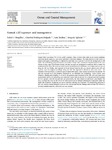Mostrar o rexistro simple do ítem
Coastal Cliff Exposure and Management
| dc.contributor.author | Bergillos, Rafael J. | |
| dc.contributor.author | Rodríguez-Delgado, Cristóbal | |
| dc.contributor.author | Medina-Rodríguez, Luis | |
| dc.contributor.author | Iglesias, Gregorio | |
| dc.date.accessioned | 2020-10-30T18:28:37Z | |
| dc.date.available | 2020-10-30T18:28:37Z | |
| dc.date.issued | 2020 | |
| dc.identifier.citation | Bergillos, R. J., Rodriguez-Delgado, C., Medina, L., & Iglesias, G. (2020). Coastal cliff exposure and management. Ocean and Coastal Management, 198 (105387). DOI:10.1016/j.ocecoaman.2020.105387 | es_ES |
| dc.identifier.uri | http://hdl.handle.net/2183/26613 | |
| dc.description.abstract | [Abstract:] Coastal cliffs cover about 75% of the world's coastlines. Many of these cliffs suffer severe erosion problems, which are mainly caused by wave action and lead to important damages. The main objective of this work is to propose and apply a methodology to characterize and map wave exposure levels for the management of cliff coasts. The methodology proposed consists of a number of steps. First, a statistical characterization of the wave climate in deep water is performed. Second, relevant sea states are propagated towards the cliff by means of a numerical model. Then, the results are used to assess the distribution of significant wave heights and wave power along the cliff toe. Finally, four exposure levels are defined based on the wave power values at the cliff, and exposure zones are mapped accordingly along the cliff. This approach is illustrated with a case study – the Catedrales Cliffs and Beach, a tourism hotspot in Galicia (NW Spain) where erosion caused loss of human life. We find that exposure levels are primarily influenced by the nearshore bed morphology, which controls wave refraction, shoaling and breaking, as well as by the geometry and orientation of the cliff, with some parts more exposed than others to the prevailing wave direction. On the islets off the cliff the windward faces have a greater level of exposure, since the leeward faces are protected by the islets themselves and lower water depths. The rocky outcrops that occur at the cliff toe in some sections act as emerged (submerged) breakwaters under low (high) tide conditions, dissipating wave power and thus reducing wave exposure. The methodology proposed in this work enables coastal managers to prevent the personal and material damages derived from cliff erosion by focusing remedial measures where they are most needed. | es_ES |
| dc.description.sponsorship | Ministerio de Ciencia, Innovación y Universidades; FJCI-2017-31781 | es_ES |
| dc.language.iso | eng | es_ES |
| dc.publisher | Elsevier | es_ES |
| dc.relation.uri | https://doi.org/10.1016/j.ocecoaman.2020.105387 | es_ES |
| dc.rights | Atribución 4.0 España | es_ES |
| dc.rights.uri | http://creativecommons.org/licenses/by/4.0/es/ | * |
| dc.subject | Cliff | es_ES |
| dc.subject | Erosion | es_ES |
| dc.subject | Wave | es_ES |
| dc.subject | Exposure | es_ES |
| dc.subject | Mapping | es_ES |
| dc.subject | Management | es_ES |
| dc.title | Coastal Cliff Exposure and Management | es_ES |
| dc.type | journal article | es_ES |
| dc.rights.accessRights | open access | es_ES |
| UDC.journalTitle | Ocean and Coastal Management | es_ES |
| UDC.volume | 198 | es_ES |
| dc.identifier.doi | 10.1016/j.ocecoaman.2020.105387 | |
| UDC.coleccion | Investigación | es_ES |
| UDC.departamento | Enxeñaría Civil | es_ES |
| UDC.grupoInv | Grupo de Estradas, Xeotecnia e Materiais (CGM) | es_ES |
| UDC.institutoCentro | CITEEC - Centro de Innovación Tecnolóxica en Edificación e Enxeñaría Civil | es_ES |
Ficheiros no ítem
Este ítem aparece na(s) seguinte(s) colección(s)
-
Investigación (ETSECCP) [826]






